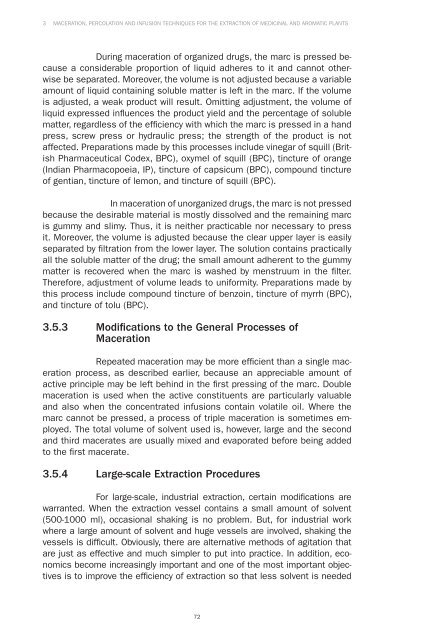Extraction Technologies For Medicinal And Aromatic Plants - Unido
Extraction Technologies For Medicinal And Aromatic Plants - Unido
Extraction Technologies For Medicinal And Aromatic Plants - Unido
Create successful ePaper yourself
Turn your PDF publications into a flip-book with our unique Google optimized e-Paper software.
3 MACERATION, PERCOLATION AND INFUSION TECHNIQUES FOR THE EXTRACTION OF MEDICINAL AND AROMATIC PLANTS<br />
During maceration of organized drugs, the marc is pressed because<br />
a considerable proportion of liquid adheres to it and cannot otherwise<br />
be separated. Moreover, the volume is not adjusted because a variable<br />
amount of liquid containing soluble matter is left in the marc. If the volume<br />
is adjusted, a weak product will result. Omitting adjustment, the volume of<br />
liquid expressed infl uences the product yield and the percentage of soluble<br />
matter, regardless of the effi ciency with which the marc is pressed in a hand<br />
press, screw press or hydraulic press; the strength of the product is not<br />
affected. Preparations made by this processes include vinegar of squill (British<br />
Pharmaceutical Codex, BPC), oxymel of squill (BPC), tincture of orange<br />
(Indian Pharmacopoeia, IP), tincture of capsicum (BPC), compound tincture<br />
of gentian, tincture of lemon, and tincture of squill (BPC).<br />
In maceration of unorganized drugs, the marc is not pressed<br />
because the desirable material is mostly dissolved and the remaining marc<br />
is gummy and slimy. Thus, it is neither practicable nor necessary to press<br />
it. Moreover, the volume is adjusted because the clear upper layer is easily<br />
separated by fi ltration from the lower layer. The solution contains practically<br />
all the soluble matter of the drug; the small amount adherent to the gummy<br />
matter is recovered when the marc is washed by menstruum in the fi lter.<br />
Therefore, adjustment of volume leads to uniformity. Preparations made by<br />
this process include compound tincture of benzoin, tincture of myrrh (BPC),<br />
and tincture of tolu (BPC).<br />
3.5.3 Modifi cations to the General Processes of<br />
Maceration<br />
Repeated maceration may be more effi cient than a single maceration<br />
process, as described earlier, because an appreciable amount of<br />
active principle may be left behind in the fi rst pressing of the marc. Double<br />
maceration is used when the active constituents are particularly valuable<br />
and also when the concentrated infusions contain volatile oil. Where the<br />
marc cannot be pressed, a process of triple maceration is sometimes employed.<br />
The total volume of solvent used is, however, large and the second<br />
and third macerates are usually mixed and evaporated before being added<br />
to the fi rst macerate.<br />
3.5.4 Large-scale <strong>Extraction</strong> Procedures<br />
<strong>For</strong> large-scale, industrial extraction, certain modifi cations are<br />
warranted. When the extraction vessel contains a small amount of solvent<br />
(500-1000 ml), occasional shaking is no problem. But, for industrial work<br />
where a large amount of solvent and huge vessels are involved, shaking the<br />
vessels is diffi cult. Obviously, there are alternative methods of agitation that<br />
are just as effective and much simpler to put into practice. In addition, economics<br />
become increasingly important and one of the most important objectives<br />
is to improve the effi ciency of extraction so that less solvent is needed<br />
72

















